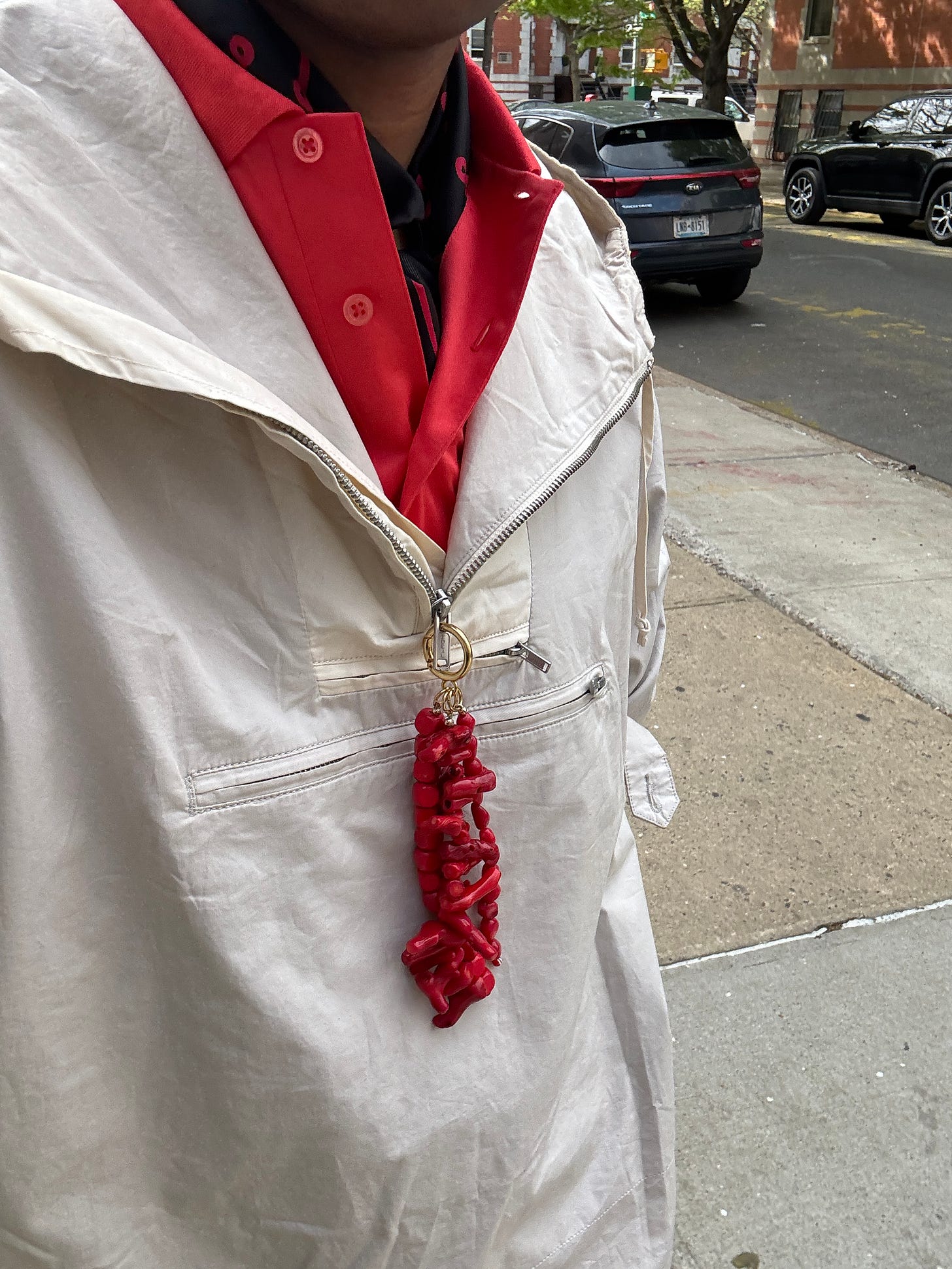But first…is there life for all your bag charms as….

Of course I can’t claim complete originality here—I got the idea from the Kallmeyer PF25 lookbook, which honestly felt like a bit of a cosmic shift. Daniella Kallmeyer just knows how to take a minimalist palette and make it feel exciting and sexy. And I have to say, having someone like Caitlin Burke style it (she also did the FW25 show) makes all the difference. She has such a good eye and this way of styling that sits right between realistic and a little bit dreamy, which makes the looks not only feel wearable but also like something you want to try to recreate.
There was so much goodness in the collection (like this and this—I think it should start landing in stores around June or July), but one of the pieces that really stuck with me was this anorak with a beaded paracord charm attached to the zipper. The charm is removable, so you could easily clip it onto a bag or anything else.
The modern dilemma when it comes to shopping and getting dressed is that most things feel derivative of something else—because more often than not, they are. Then there are the pieces that are great in theory but either feel out of reach or simply don’t work for everyday life. Which is why, for the past year (and probably for the foreseeable future), I’ve come to see jewelry—and accessories more broadly—as the real stars of a look. That’s where the distinction happens.
The bag charm boom, for instance, yes very much about the decoration of it all, but at the same time maybe it more so about trying to emulate Jane Birkin or maybe just the idea of her being that it was her passing that no doubt was the catalyst for the trend. (Because if we’re being honest, all these muses we throw on moodboards or cite as style icons—we’re responding more to the idea of them than the reality. And let’s face it, the idea is often more interesting. But I digress.)
That’s not to say the zipper charm—or maybe zipper adornment sounds better—is as directly tied to a specific person or even the idea of a person the way the bag charm was. But it does carry that same sense of fun. One thing I noticed, just walking around the block with it dangling from the zipper, was the weight. You could feel it as it hung there, and then the swing—it moved in rhythm with me. And maybe it’s my lingering cold or the general mood of the day, but there was something oddly spiritual about it. This quiet, meditative reminder of movement and intention. I had to run out to pick up wine for Nick to make sauce, and on the way to the store, my focus was split between the errand and this charm, swaying with every step.
Spiritual tangent aside, the root of it is this: it’s a small addition, sure, but a personal one. And that’s what makes it feel special.
The only way someone could copy my look exactly would be to have the same charm, the same anorak, the same everything. So if someone were to recreate it, they’d naturally do it in their own way—with their own charm, their own jacket. And that’s kind of the point.
Which brings me to the real question at the heart of all this: how exactly does one shop in T****’s America?
Tariro Makoni recently published a piece called “Trending: Tariff Dressing,” and part of the brilliance is in the name itself. She describes tariff dressing as something related to recession dressing, but not quite the same. In her words:
Even though consumers are experiencing recession anxiety, I think it’s too simplistic to bucketize their response to tariffs as recession-wear. Instead, tariff dressing is like her chaotic fraternal twin — much more unpredictable, but they share the same source DNA. Here, recession energy served as a withdrawal (beige, qu*et luxury) and tariff dressing serves as an emotional reaction… a preemptive adaptation to the uncertainty of what’s next (and how it will actually impact your downstream).
She connects the moment to the 1930s and early 1980s, eventually landing on the idea of Defiant Aspiration, a time when, despite economic instability, people leaned into dressing in a way that felt ambitious and elevated. Another major point she makes is about the return of the statement necklace. (And not to derail, but I’ve been deep in a RHONY rewatch and completely forgot how committed the ladies were to their statement necklaces.)
It’s a great read. If you have the time, I’d recommend checking it out. It’s behind a paywall, so if you want the full thing, you’ll need to subscribe. The only thing I’d add—and maybe she’s getting to this later since she hinted the piece is part of a larger series—is a bit more historical context around production (I’m also assuming she’s going to talk about Yuppies?).
Yes, the 1930s and early 1980s were marked by economic strain, and tariffs did play a role. But a key difference between then and now is where our clothes come from. In the 1930s, most clothing worn in the U.S. was produced domestically. Imports were rare and typically considered luxury. And while the 1980s marked the beginning of offshoring, a significant portion of clothing was still made in the U.S. It wasn’t until the late ’80s and especially the ’90s that production shifted abroad in a major way.
When it comes to history, it's important. How can we know where we're going if we don't understand where we've been? But don't confuse that with the idea that history is just a continuous loop of reoccurrences.
Of course, it’s easy to stand firmly in that belief (and who knows, maybe I’m completely wrong and some higher being does have us on an endless loop). But thinking specifically about the U.S., decisions are often made more in reaction than in foresight. So yes, we do sometimes make the same mistake twice. But I also think people find comfort in the belief that history repeats itself, because it’s easier to believe we’ve been through something like this before. It’s much harder to sit with the idea that we might be in uncharted territory.
I also think it’s important to note that there might be some real resistance—not just in pricing, but in how people interact with the process of getting their goods. Lately, I’ve come across TikToks, Substack posts, and heard firsthand from friends about various issues with receiving orders from certain sites. In some cases, customs delays have slowed down deliveries, packages have required additional fees before release, or recipients have had to go to a local delivery outpost as well as pay charges before they could even take their items home. All of that adds up to yet another hurdle for the consumer, especially with prices already on the rise.
Still, it’s not all doom and gloom. If you’re in the mood to shop stateside but don’t want to stress about tariffs, vintage and secondhand might be your golden ticket. While there may be some trickle-down price increases on platforms like The RealReal, Fashionphile, or even among sellers on eBay, Etsy, and Grailed, I doubt they’ll compare to what we might see come fall. Plus, you can still score pieces from your favorite European brands or versions of those brands (JWA era Loewe, RIP) without the added fees—and in some cases, you might even find the original piece that inspired what walked the runway, or at least something that gets you close, for a lot less.
To continue to build on Tariro’s point, I really do think this is the moment for statement necklaces—or really, statement jewelry across the board. Just like the zipper charm I mentioned earlier, jewelry is a personal marker. It’s a simple way to make something feel yours. Of course, it’s not without complications. Gold prices are at an all-time high, which only makes fine and high jewelry more exclusive. But if we’re talking about long-term value, jewelry often holds it better than clothing. Most resale pricing in fashion is based more on hype and provenance than actual material worth.

Keep reading with a 7-day free trial
Subscribe to Consider Yourself Cultured to keep reading this post and get 7 days of free access to the full post archives.








